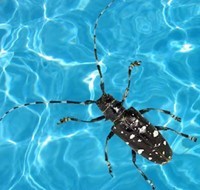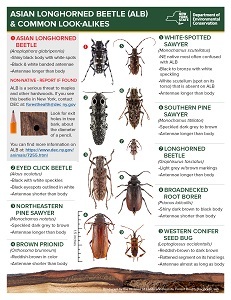Own a Pool? Help DEC Look for Asian Longhorned Beetles
 DEC is encouraging swimming pool owners to participate in the annual Asian Longhorned Beetle Swimming Pool Survey. During late summer, Asian longhorned beetles (ALB) emerge as adults and are active outside of their host tree. The goal of the survey is to locate infestations of these invasive pests before they cause serious damage to the State’s forests and street trees.
DEC is encouraging swimming pool owners to participate in the annual Asian Longhorned Beetle Swimming Pool Survey. During late summer, Asian longhorned beetles (ALB) emerge as adults and are active outside of their host tree. The goal of the survey is to locate infestations of these invasive pests before they cause serious damage to the State’s forests and street trees.
From now until swimming pools are closed for the season, DEC is asking pool owners to periodically check their filters for insects that resemble ALB, and report suspects either by emailing photos or mailing insects to DEC’s Forest Health Diagnostics Lab at 108 Game Farm Road, Delmar, NY 12054, Attn: Liam Somers.
People without swimming pools can help the effort by reporting signs of ALB in their communities. The invasive pest ALB:
- is about 1.5 inches long, black with white spots, and have black and white antennae;
- leave perfectly round exit holes about the size of a dime in branches and trunks of host trees;
- and create sawdust-like material called frass that collects on branches and around the base of trees.
 ALB are wood-boring beetles native to Asia that were accidentally introduced to the United States through wood-packing materials. These pests attack a variety of hardwoods, including maples, birches, and willows, among others, and have caused the death of hundreds of thousands of trees across the country. The State Department of Agriculture and Markets has worked diligently to manage ALB infestations in New York, successfully eradicating them from Brooklyn, Staten Island, Manhattan, Islip, and Queens. The beetle is still actively managed in central Long Island, and there are active infestations in Massachusetts, Ohio, and South Carolina.
ALB are wood-boring beetles native to Asia that were accidentally introduced to the United States through wood-packing materials. These pests attack a variety of hardwoods, including maples, birches, and willows, among others, and have caused the death of hundreds of thousands of trees across the country. The State Department of Agriculture and Markets has worked diligently to manage ALB infestations in New York, successfully eradicating them from Brooklyn, Staten Island, Manhattan, Islip, and Queens. The beetle is still actively managed in central Long Island, and there are active infestations in Massachusetts, Ohio, and South Carolina.
For more information on the ALB Swimming Pool Survey and ALB, including biology and identification tools, visit DEC’s website.
Image: View a poster of Asian longhorned beetle identification tips, including common look-alike species, on DEC’s website.
Posted: August 24th, 2021 under Environmental News, State Government News.
